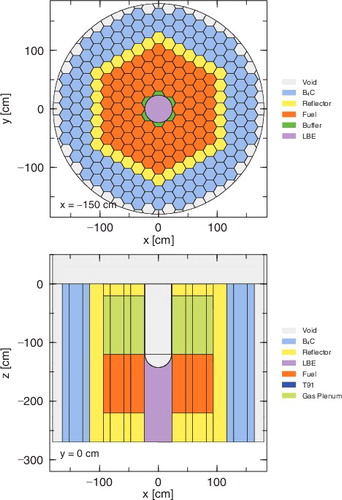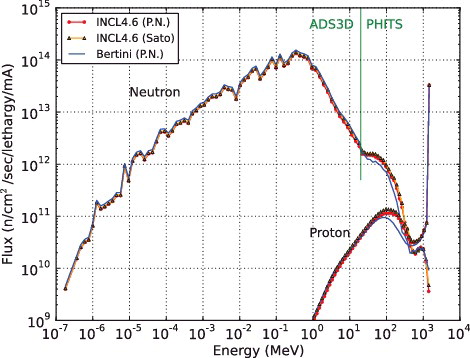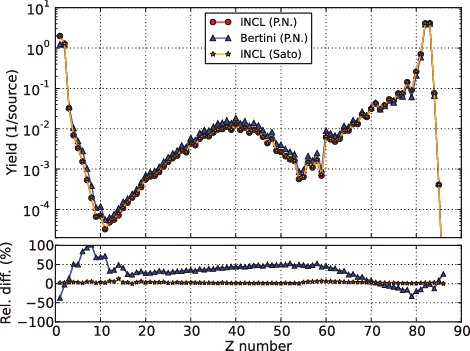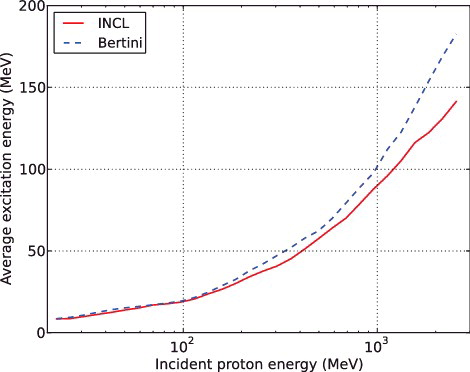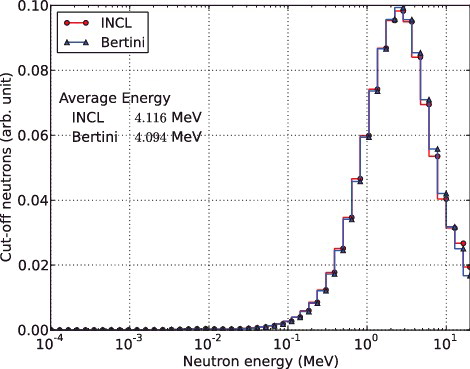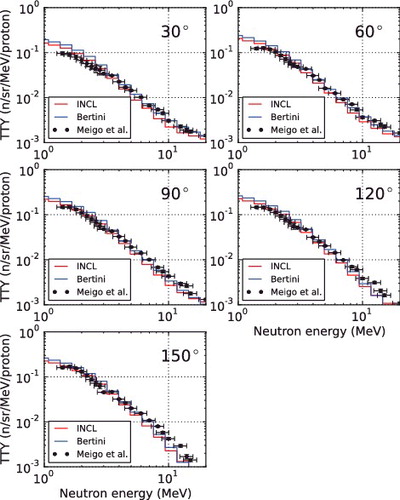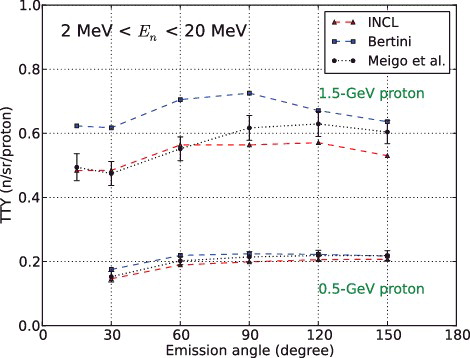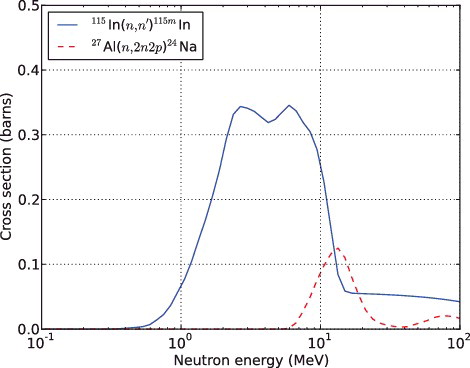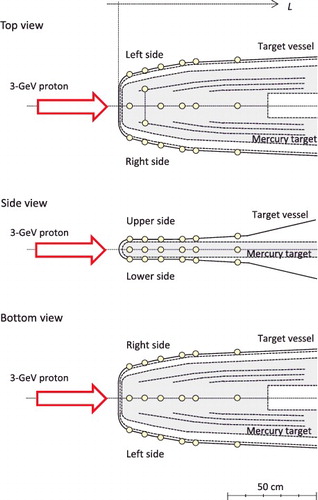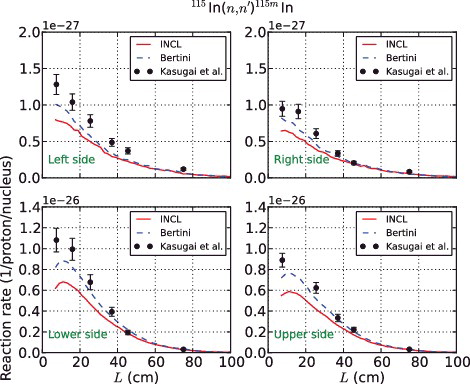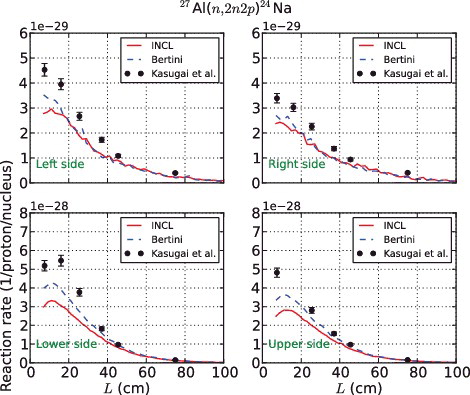 ?Mathematical formulae have been encoded as MathML and are displayed in this HTML version using MathJax in order to improve their display. Uncheck the box to turn MathJax off. This feature requires Javascript. Click on a formula to zoom.
?Mathematical formulae have been encoded as MathML and are displayed in this HTML version using MathJax in order to improve their display. Uncheck the box to turn MathJax off. This feature requires Javascript. Click on a formula to zoom.ABSTRACT
The impact of different spallation models and parametrisation of nucleon–nucleus interactions in the particle transport code PHITS on the nuclear characteristics of an accelerator-driven system (ADS) is investigated. Cut-off neutrons below 20 MeV calculated using the default option of the current spallation model (i.e. Liège intranuclear cascade (INC) model version 4.6, INCL4.6) are found to be 14% less than those calculated by the old spallation model (i.e. Bertini INC model). This decrease increases the proton beam current that drives the 800-MW thermal power and impacts various ADS parameters, including material damage, nuclear heating of the proton beam window and the inventory of spallation products. To validate these options based on the ADS neutronics design, we conduct benchmark calculations of the total and non-elastic cross sections, thick target neutron yields and activation reaction rate distributions. The results suggest that Pearlstein–Niita systematics, which is a default option of the nucleon–nucleus interaction parametrisation, would be the best option and that Bertini INC is better suited for cut-off neutrons than INCL4.6. However, because of the difficulty in making a definite conclusion on the spallation models, we conclude that relatively large uncertainty in the cut-off neutrons, which is the difference between the two spallation models (i.e. 14%), should be considered.
1. Introduction
To reduce the burden of geometrical disposal of high-level waste (HLW), the Japan Atomic Energy Agency (JAEA) has conducted research and development (R&D) on an accelerator-driven system (ADS) to transmute minor actinides (MAs) included in HLW [Citation1,Citation2]. In the R&D of ADS, high-energy nuclear reaction models, namely spallation models, incorporated in the Monte Carlo transport code, PHITS [Citation3], have played an important role in the design of ADS neutronics.
Since the development of PHITS version 2.52, the Liège intranuclear cascade (INC) model version 4.6 (INCL4.6) [Citation4] has been employed as the default model for the INC calculation in PHITS instead of the Bertini INC model [Citation5]. Within the International Atomic Energy Agency (IAEA) benchmark programme framework, a benchmark survey of spallation models used in the Monte Carlo transport codes such as PHITS, MCNPX [Citation6] and Geant4 [Citation7] demonstrated that INCL4.5 (the former version of INCL) coupled with the nuclear de-excitation model, ABLA, i.e. INCL4.5/ABLA [Citation8], was most accurate for physical quantities such as cross sections and neutron multiplicities[Citation9]. However, since PHITS adopts its own de-excitation model, GEM [Citation10], and parametrises nucleon–nucleus interactions (i.e. nucleon-induced total, non-elastic and elastic cross sections), referred to as Pearlstein–Niita (hereafter PN) systematics [Citation11] as default, the INCL4.6 results incorporated in PHITS could differ from the benchmark ones. In addition to the change in the default option in PHITS, Sato et al. [Citation12] recently demonstrated that the accuracy of the cosmic-ray propagation simulation in the atmosphere, the so-called air shower simulation, can be improved using PHITS coupled with a new parametrisation for nucleon–nucleus interactions (i.e. Sato systematics).
Due to the recent progress in PHITS code capabilities, investigating the impact of the change in the spallation model and parametrisations on the ADS nuclear characteristics is necessary because such a change in default options could force an alteration in the design of the previously proposed ADS[Citation13–17]. Therefore, this study primarily aims to investigate the impact of different spallation models (i.e. INCL4.6 and Bertini INC models) and parametrisations (i.e. the PN and Sato systematics) on the ADS nuclear characteristics. Another purpose of this study is to validate these models in PHITS by comparing with experimental results, which were not included in the IAEA benchmark, from the perspective of ADS neutronics design.
In this study, three kinds of options were employed as summarised in : (a) INCL (PN)–INCL4.6 and the PN systematics, which is the default model of the current version, (b) Bertini (PN)–the Bertini INC for the spallation model and the PN systematics for parametrisation of nucleon–nucleus interactions, which is the default model of the former version of PHITS and (c) INCL (Sato)–INCL4.6 and the Sato systematics. For all cases, the de-excitation model GEM was employed.
Table 1. Model parameters used.
This paper is organised as follows. First, the calculations employed in estimating the impact on the ADS design are described in Section 2. In Section 3, the results obtained with the above three options are presented and compared. Section 4 aims to validate the calculations by comparing the results from the models and experiments. Finally, Section 5 provides a summary of the important conclusions from this investigation.
2. Calculation conditions
2.1. ADS characteristics
In this study, we employed the ADS proposed by JAEA, namely lead bismuth eutectic (LBE) cooled tank-type ADS with MA and plutonium nitride fuel ((MA+Pu)N). Since a detailed description of the proposed ADS is given in [Citation13,Citation14], only a brief explanation is provided here. lists the main characteristics of the ADS. Fuel composition is adjusted so that keff = 0.97 at the beginning of the cycle (BOC) by mixing zirconium nitride (ZrN) as an inert matrix. Here, the fuel composition at the BOC is listed in and that of other constituents can be found in [Citation18].
Table 2. Main characteristics of ADS.
Table 3. Fuel composition at BOC.
shows horizontal and vertical cross sections of the PHITS model. To obtain the neutrons required to drive a subcritical assembly of 800 MWth, a 1.5-GeV proton beam is directed to the LBE spallation target at the centre of the core. Since the proton beam current increases as keff decreases in order to maintain the thermal power during a burnup cycle of the operation, the proton beam window (PBW) irradiation between the vacuum beam tube and LBE becomes severe. Characteristics of the proton beam and PBW (e.g. shape, dimension, material) were determined from the feasibility study in a previous work [Citation16].
2.2. Calculation procedure and tools
To obtain particle fluxes, a transport calculation with 1.5-GeV proton source was performed for neutrons, photons and charged particles. Although, in principle, this calculation for the subcritical system can be conducted by a single transport code, it was divided into two steps to avoid excessive calculation time: (1) high-energy calculation (neutrons above 20 MeV and other particles) and (2) low-energy calculation (neutrons below 20 MeV). In the first step, the transport calculation using the 1.5-GeV proton source was performed with PHITS, where neutrons produced at energies below 20 MeV were neglected, but information on their quantity, position and momentum was retained so as to use them in subsequent calculations. Here, the dumped neutron is referred to as a cut-off neutron. Next, a low-energy neutron flux was obtained by solving the fixed-source problem with a deterministic model imposing the cut-off neutrons on the transport equation as a neutron source. Using the calculated neutron flux and the operation profile, burnup and inventory calculations were conducted.
summarises computational codes/modules and a nuclear data library used in this analysis. Reactor physics calculations, including the fixed-source calculation, were performed using a three-dimensional reactor analysis code system for ADS, ADS3D [Citation18], which is the framework system based on deterministic models. The JENDL-4.0 [Citation19] nuclear data library was used for the low-energy calculations. Here, to generate the effective cross sections with 73-energy-group structure by the SLAROM-UF code [Citation20], the fast reactor group constant set on the basis of JENDL-4.0, UFLIB.J40U1 [Citation21] was employed. Both criticality and fixed-source calculations were performed with the deterministic transport code PARTISN [Citation22]. The burnup of the fuel was calculated by the burnup calculation module BURNUP [Citation23]. The inventory of spallation products (SPs) was calculated with DCHAIN-SP2001 [Citation24].
Table 4. Nuclear data libraries and calculation modules used.
3. Comparison of nuclear characteristics
3.1. Parameters per unit source
summarises the calculated peak values of the parameters relevant to material damage (i.e. helium and hydrogen gas production and displacement per atom (DPA)) and nuclear heat density per 1 mA at PBW. The listed parameters for neutrons above 20 MeV and other particles were calculated by PHITS. Here, the DPA cross section of the beam window material (i.e. modified 9Cr-1Mo steel, T91) was calculated as in Iwamoto et al.[Citation25]. The values of helium gas production rate PHe, hydrogen gas production rate PH and DPA rate Pdpa for neutrons below 20 MeV at PBW were obtained by
(1)
(1) where φPBWi denotes the ith group neutron flux at PBW calculated by ADS3D, and σHei, σHi and σdpai represent the helium and hydrogen gas production cross sections and the DPA T91 cross section, respectively. The nuclear heat density H, for neutrons below 20 MeV, was obtained by
(2)
(2) where N is the T91 number density and Ki is the kinetic energy release in materials (KERMA) factor of T91. Here, the groupwise cross sections σHei, σHi and σdpai, and the T91 KERMA factor Ki were calculated by PHITS using JENDL-4.0.
Table 5. Peak values of parameters related to radiation damage and nuclear heat density per 1 mA at PBW at BOC. The symbols n and p denote contributions from neutrons and protons, respectively.
Large differences were not observed between Bertini INC and INCL4.6, but there were differences between PN and Sato systematics for both helium and hydrogen gas productions. shows neutron and proton energy spectra per 1 mA at PBW. Although the neutron spectrum has a large peak around several hundred keV, helium and hydrogen gas production by low-energy neutrons is relatively small because of their reaction thresholds. In contrast, the proton spectrum has a strong peak at 1.5 GeV, which implies that the difference in helium and hydrogen gas production is mainly affected by the difference in the PBW interactions at 1.5 GeV as shown in , where the Sato systematics yield higher cross sections for energies above 500 MeV.
Figure 3. Total cross sections of 56Fe for an incident proton and neutron, and the relative difference from the Pearlstein–Niita systematics.
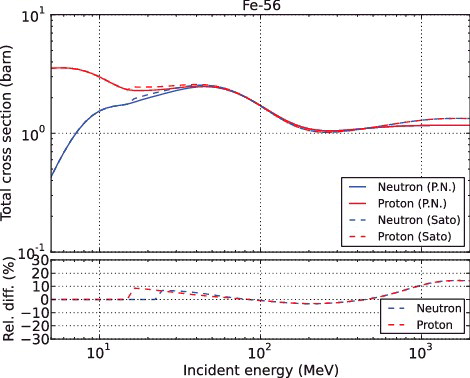
compares the T91 helium and hydrogen gas production cross sections as a function of incident proton energy. Since INCL4.6 incorporates a cluster production mechanism during the INC process [Citation4], which is not included in Bertini INC, the differences between spallation models could impact those parameters. However, as shown in left panels of , the difference in the INCL4.6 and Bertini INC cross sections around 1.5 GeV is relatively small. This implies that helium is predominantly produced through evaporation instead of INC.
Figure 4. Helium and hydrogen gas production cross sections of T91 as a function of incident proton energy and the relative difference from INCL (P.N.).
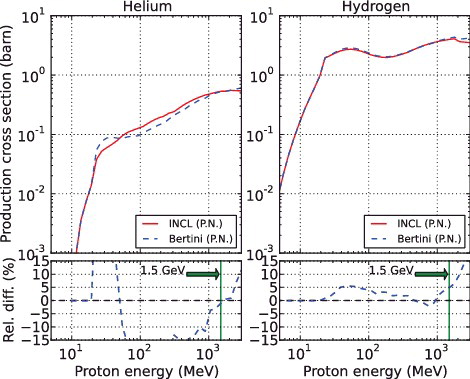
The nuclear heat is mainly generated by 1.5 GeV protons through ionisation of the window material. Therefore, the nuclear heat generated by Bertini INC, which produces more hydrogen (right panels of ), is greater than that by INCL4.6. For the same reason, the Sato systematics estimates more nuclear heat than the PN systematics. In contrast, since the total DPA is dominated by low-energy neutrons due to no DPA cross-section threshold energy, the difference arises from the difference in the neutron flux below 20 MeV.
shows the SP charge distribution of the LBE target. Despite the fact that all three cases use the same model for calculating de-excitation, the INCL4.6 and Bertini INC models differ over a wide mass and charge range; this is owing to the difference in transferred excitation energy between INC and de-excitation models, as shown in . With increasing excitation energy, more particles are emitted through evaporation or high-energy fission from the excited nuclei during de-excitation. Therefore, more SPs and spallation neutrons are considered to be produced from the Bertini model calculation, compared to INCL4.6.
3.2. Burnup parameters
summarises the calculated parameters in consideration of the initial burnup cycle together with the number of cut-off neutrons. Here, burnup reactivity ρ is given by
(3)
(3) where kBOCeff and kEOCeff are the effective multiplication factors at the BOC (kBOCeff = 0.97) and the end-of-cycle (EOC), respectively. The peaking factor is defined as the peak-to-average ratio of the power produced by nuclear fission. In the table, the inventories of the volatile SP isotopes of polonium and xenon and the transmutation amount of one of the major MAs, 237Np, are shown, where fission-induced xenon is not included.
Table 6. Parameters in consideration of the initial burnup cycle, together with the number of cut-off neutrons.
There was little difference in the burnup reactivity, peaking factor and transmutation of transuranic elements, which implies that the PHITS spallation models have negligible impact on reactor physics and transmutation performance. In contrast, the number of cut-off neutrons calculated by INCL4.6 is about 14% smaller than that by Bertini INC. The INCL4.6 calculation yields about 14% higher beam current than Bertini INC. This indicates that to compensate for the reduction in cut-off neutrons, more protons are required for INCL4.6. As discussed above, this difference is attributable to the difference in excitation energy.
lists the cumulative damage-related PBW values at the peak position for the initial burnup cycle and nuclear heat density at the EOC or the most severe time during nuclear heating. The INCL4.6 results were found to be more severe than Bertini INC due to the propagation of the higher proton beam current, as described above. Comparing the results between INCL (PN) and INCL (Sato), Sato systematics were found to be progressively worse than PN systematics, which mainly results from the propagation of the difference in the nucleon–nucleus interactions.
Table 7. Cumulative peak parameter values related to the PBW radiation damage for the initial burnup cycle (600 EFPDs). The symbols n and p denote contributions from neutrons and protons, respectively.
4. Benchmark calculation
4.1. Parametrisation of nucleon–nucleus interactions
compares the proton-induced non-elastic and the neutron-induced total cross sections. Here, the experimental data are taken from [Citation26–29]. The Sato systematics agree well with the experimental data for light nuclei above 1 GeV, which is important when considering the air shower simulation. However, it appears that the PN systematics result in better agreement with the PBW and LBE constituent elements (i.e. Fe and Pb). Thus, while there is room for improvement in developing an inclusive parametrisation of nucleon–nucleus interactions, the PN systematics are likely better than Sato systematics with respect to the ADS neutronics design.
Figure 7. Comparison of proton-induced non-elastic and neutron-induced total cross sections. Experimental data of the proton-induced non-elastic cross sections and the neutron-induced total cross sections are taken from [Citation26] and [Citation27–29], respectively.
![Figure 7. Comparison of proton-induced non-elastic and neutron-induced total cross sections. Experimental data of the proton-induced non-elastic cross sections and the neutron-induced total cross sections are taken from [Citation26] and [Citation27–29], respectively.](/cms/asset/cbd792bd-dc94-4e93-b965-3aba302f60b7/tnst_a_1140598_f0007_oc.jpg)
4.2. Cut-off neutrons
As described in the previous section, the difference in the number of cut-off neutrons between INCL4.6 and Bertini INC has an impact on the differences in various ADS nuclear characteristics, including beam current, PBW material damage and SP inventory. compares the energy distribution of the cut-off neutrons between the two spallation models. Both spectra have much the same shape, which is in the range of 1–20 MeV. Therefore, to validate this parameter, benchmarking for integral neutron data in the 0.1–20 MeV energy range would be practical, for example, through thick target neutron yields (TTY) and activation reaction-rate distributions.
In the following, we focus on three benchmark problems of integral experiments: (1) a TTY experiment using a solid lead target conducted at the High-Energy Accelerator Organisation (KEK) [Citation30], (2) an activation reaction-rate experiment using a mercury target conducted at Brookhaven National Laboratory (BNL) [Citation31] and (3) a similar experiment at the Japan Proton Accelerator Research Complex (J-PARC) [Citation32].
4.2.1. Experiment of thick target neutron yields at KEK
The experiment in [Citation30] utilises neutron spectra produced from a lead thick target (15 cm on each side and 20 cm thick) bombarded by 1.5- and 0.5-GeV protons, which were measured with NE213 neutron detectors at six positions (angles of 15°, 30°, 60°, 90°, 120° and 150° from the beam direction on a horizontal plane). The experimental details are provided in [Citation30].
and illustrate the calculated energy spectra for 1.5- and 0.5-GeV protons in comparison with the measured data, respectively. In this calculation, the beam position, width, target and detector arrangements were considered. As a whole, both models well reproduce the spectral shape below 20 MeV for both incident energies. shows a comparison of the TTY angular distributions, where each experimental point was obtained by integrating a least-squares fit to the measured data from 2 to 20 MeV in and . We see from that INCL4.6 is in good agreement with the experiment at forward angles but underestimates the experiment at reverse angles. Also, it can be seen that, overall, Bertini INC overestimates the experiment.
Figure 9. Comparison of spectral thick target neutron yields for 1.5-GeV protons on 20-cm-thick lead.
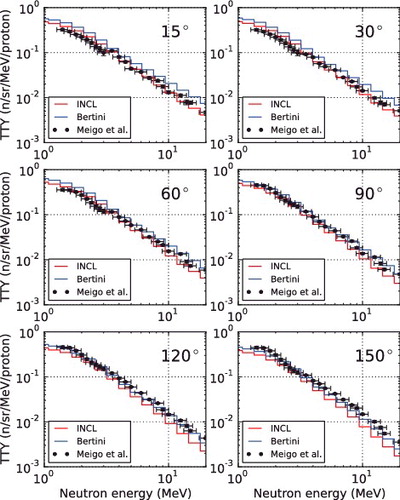
4.2.2. Activation reaction-rate distribution experiments at BNL
The experiment in [Citation31] utilises activation foils, which were attached to detector arrays installed near the cylindrical mercury target with hemispherical front ends (20 cm in diameter and 130 cm long) along the direction of the beam. Their activation reaction-rate distributions were measured for incident proton energy of 1.6, 12 and 24 GeV. A detailed description of this experiment is given in [Citation31] and geometrical modelling is provided in [Citation33].
Among the various activation detectors used in the experiment, we focused on two reactions: (1) 115In(n, n′)115mIn and (2) 27Al(n, 2n2p)24Na, which have low threshold energies of 0.34 and 3.25 MeV, respectively. Here, the cross-section data used in deriving the reaction rates were taken from the dosimetry cross sections[Citation34]. shows the activation cross sections of the 115In(n, n′)115mIn and 27Al(n, 2n2p)24Na reactions. These reactions are sensitive to neutron fluxes from ∼1 to ∼20 MeV.
shows comparisons of the calculated activation reaction rates for the 115In(n, n′)115mIn and 27Al(n, 2n2p)24Na reactions at 1.6-GeV incident energy closest to 1.5 GeV with the measured data. Although other particles can lead to the formation of 115mIn and 24Na, we confirmed that these contributions were so small that they could be ignored. For example, in the 27Al activation reaction experiment contributions of the protons, π+ and π− to the 24Na production at the highest neutron flux yield 1.1%, 0.3% and 0.6%, respectively. In contrast to the TTY benchmark experiment, Bertini INC well agrees with the measured data, whereas INCL4.6 completely underestimates the experimental data.
4.2.3. Activation reaction-rate distribution experiments at J-PARC
The experiment in [Citation32] was designed to measure activation reaction-rate distributions for 3-GeV proton incident using a mercury target mounted in the Materials and Life Science Experimental Facility [Citation35] at J-PARC. To account for the background neutrons from the structural materials around the target, the geometry was modelled as built. As shown in , activation foils were attached to a triple-wall target vessel covering the mercury target located along the direction of the beam. Activation reactions investigated in this benchmark are the same as above. The experimental details are shown in [Citation32].
and show comparisons of the calculated activation reaction rates for 115In(n, n′)115mIn and 27Al(n, 2n2p)24Na reactions with the measured data, respectively. Although both models underestimate the measured data, Bertini INC was in better agreement than INCL4.6 for the 115In(n, n′)115mIn and 27Al(n, 2n2p)24Na reactions.
5. Conclusion
We investigated the impact of the different spallation models and parametrisations in PHITS on the ADS nuclear characteristics. The number of cut-off neutrons below 20 MeV showed discrepancies up to 14% between the different spallation models, and this difference impacts not only the proton beam current that drives the 800-MW thermal power but also the PBW parameters and SP inventory. In contrast, the reactor physics and transmutation performance were hardly affected.
From the comparison of total and non-elastic cross sections using the nucleon–nucleus interaction parametrisations with the experimental data, the results suggest that the PN systematics are superior to the Sato systematics with respect to the ADS neutronics design. In terms of the cut-off neutrons, the results of the activation reaction-rate distributions suggest that Bertini INC would be more suitable than INCL4.6. However, Bertini INC overestimates the experimental TTY data overall, whereas INCL4.6 is in good agreement with it, especially in the forward direction. Hence, relatively large uncertainties in the cut-off neutrons, which is the difference between the two spallation models (i.e. 14%) should be considered, which would affect the ADS design study especially for PBW.
To reduce this uncertainty, it is necessary to examine the cause of the discrepancy between the experiment at KEK and the latter two experiments at BNL and J-PARC. Moreover, theoretical efforts are also important. From this study, the difference in the number of cut-off neutrons between INCL4.6 and Bertini INC was attributed to the differences in excitation energy, which connects the INC process to the de-excitation process. This indicates that improvements in theoretical models, which describe the de-excitation process or an intermediate between the two processes, will contribute to a reliable estimation of the number of cut-off neutrons.
Disclosure statement
No potential conflict of interest was reported by the authors.
This article was originally published with errors. This version has been corrected. Please see Erratum (http://dx.doi.org/10.1080/00223131.2016.1163007).
References
- Tsujimoto K, Oigawa H, Ouchi H, et al. Research and development program on accelerator driven subcritical system in JAEA. J Nucl Sci Technol. 2007;44:483–490.
- Sasa T, Oigawa H. Studies on accelerator-driven system in JAEA. Plasma Fusion Res. 2014;9:4401113.
- Sato T, Niita K, Matsuda N, et al. Particle and heavy ion transport code system PHITS, Version 2.52. J Nucl Sci Technol. 2013;50:913–923.
- Boudard A, Cugnon J, David JC, et al. New potentialities of the Liège intranuclear cascade model for reactions induced by nucleons and light charged particles. Phys Rev C. 2013;87:014606.
- Bertini HW. Intra-nuclear cascade calculation of the secondary nucleon spectra from nucleon–nucleus interactions in the energy range 340 to 2900 MeV and comparisons with experiment. Phys Rev. 1969;188:1711–1730.
- Pelowitz DB, editor. MCNPX user's manual, Version 2.7.0. Los Alamos: Los Alamos National Laboratory; 2011. (LA-CP-11-00438).
- Agostinelli S, et al. Geant4–a simulation toolkit. Nucl Instrum Meth A. 2003;506:250–303.
- Kelic A, Ricciardi MV, Schmidt KH. abla07–towards a complete description of the decay channels of a nuclear system from spontaneous fission to multifragmentation. In: Filges D, Leray S, Yariv Y, Mengoni A, Stanculescu A, Mank G, editors. Proceedings of the Joint ICTP-IAEA Advanced Workshop on Model Codes for Spallation Reactions. Trieste: ICTP; p. 181–221.
- David JC, Filges D, Gallmeier F, et al. Benchmark of spallation models. Prog Nucl Sci Technol. 2011;2:942–947.
- Furihata S. Statistical analysis of light fragment production from medium energy proton-induced reactions. Nucl Instrum Meth B. 2000;171:251–258.
- Niita K, Takada H, Meigo S, et al. High-energy particle transport code NMTC/JAM. Nucl Instrum Meth B. 2000;184:406–420.
- Sato T, Kataoka R, Yasuda H, et al. Air shower simulation for WASAVIES: warning system for aviation exposure to solar energetic particles. Radiat Prot Dosim. 2013;1–5.
- Tsujimoto K, Oigawa H, Kikuchi K, et al. Feasibility studies of lead-bismuth-cooled accelerator-driven system for minor-actinide transmutation. Nucl Technol. 2008;161:315–328.
- Nishihara K, Iwanaga K, Tsujimoto K, et al. Neutronics design of accelerator-driven system for power flattening and beam current reduction. J Nucl Sci Technol. 2008;45(8):812–822.
- Nishihara K, Kikuchi K. Irradiation damage to the beam window in the 800 MWth accelerator-driven system. J Nucl Mater. 2008;377:298–306.
- Sugawara T, Nishihara K, Obayashi H, et al. Conceptual design study of beam window for accelerator-driven system. J Nucl Sci Technol. 2010;47:953–962.
- Iwamoto H, Nishihara K, Sugawara T, et al. Sensitivity and uncertainty analysis for an accelerator-driven system with JENDL-4.0. J Nucl Sci Technol. 2013;50:856–862.
- Sugawara T, Hirai Y, Nishihara K, et al. Development of three-dimensional reactor analysis code system for accelerator-driven system, ADS3D. Tokai: Japan Atomic Energy Agency; 2014. (JAEA-Data/Code 2014-024). Japanese.
- Shibata K, Iwamoto O, Nakagawa T, et al. JENDL-4.0: a new library for nuclear science and engineering. J Nucl Sci Technol. 2011;48(9):1–30.
- Hazama T, Chiba G, Sato W, et al. SLAROM-UF: Ultra fine group cell calculation code for fast reactor–Version 20090113–(Translated Document). Tokai: Japan Atomic Energy Agency; 2009. (JAEA-Review 2009-003).
- Sugino K, Jin T, Hazama T, et al. Preparation of fast reactor group constant sets UFLIB.J40 and JFS-3-J4.0 based on the JENDL-4.0 data. Tokai: Japan Atomic Energy Agency; 2012. (JAEA-Data/Code 2011-017).
- Alcouffe RE, Baker RS, Dahl JA, et al. PARTISN: a time-dependent parallel neutral particle transport code system. Los Alamos: Los Alamos National Laboratory; 2005. (LA-UR-05-3925).
- Yokoyama K, Tatsumi M, Hirai Y, et al. Development of the next generation reactor analysis code system, MARBLE. Tokai: Japan Atomic Energy Agency; 2011. (JAEA-Data/Code 2010-030). Japanese.
- Kai T, Maekawa F, Kosako K, et al. DCHAIN-SP 2001: high energy particle induced radioactivity calculation code. Tokai: Japan Atomic Energy Research Institute; 2001. (JAERI-Data/Code 2001-016). Japanese.
- Iwamoto Y, Iwamoto H, Harada M, et al. Calculation of displacement cross-sections for structural materials in accelerators using PHITS event generator and its applications to radiation damage. J Nucl Sci Technol. 2014;51:98–107.
- Dietrich FS, Hartouni EP, Johnson SC, et al. Proton reaction cross sections measured in the BNL/AGS E943 experiment. J Nucl Sci Technol Suppl. 2002;2:269–271.
- Carlson PJ, Diddens AN, Giacomelli G, et al. Elastic and charge exchange scattering of elementary particles, Landolt-Bornstein, numerical data and functional relationships in science and technology. Berlin: Springer-Verlag; 1973.
- Abfalterer WP, Bateman FB, Dietrich FS, et al. Measurement of neutron total cross sections up to 560 MeV. Phys Rev C. 2001;63:044608.
- Schimmerling W, Devlin TJ, Jhonson WW, et al. Neutron-nucleus total and inelastic cross sections: 900 to 2600 MeV/c. Phys Rev C. 1973;7:248–262.
- Meigo S, Takada H, Chiba S, et al. Measurements of neutron spectra produced from a thick lead target bombarded with 0.5- and 1.5-GeV protons. Nucl Instrum Methods Phys Res A. 1999;431:521–530.
- Takada H, Kasugai Y, Nakashima H, et al. Measurements of activation reaction rate distribution on mercury target bombarded with high-energy protons at AGS. Tokai: Japan Atomic Energy Research Institute; 2000. (JAERI-Data/Code 2000-008).
- Kasugai Y, Harada M, Kai T, et al. Measurement of high-energy neutron fluxes and spectra around the J-PARC mercury spallation neutron target using multi-foil activation method. Tokai: Japan Atomic Energy Agency; 2015. (JAEA-Data/Code 2015-033).
- Matsuda N, Iwamoto Y, Harada M, et al. Analyses of benchmark problems for the shielding design of high energy intensity proton accelerator facilities. Tokai: Japan Atomic Energy Agency; 2008. (JAEA-Technology 2008-030).
- Maekawa F, Möllendorff UV, Wilson P, et al. Production of a dosimetry cross section set up to 50 MeV. In: Williams JG, Vehar DW, Ruddy FH, Gilliam DM, editors. Proceedings of the 10th International Symposium on Reactor Dosimetry; 1999 Sep 12–17; Osaka. Conshohocken (PA): American Society for Testing and Materials; 2001. p. 417.
- http://www.j-parc.jp/index-e.html.

